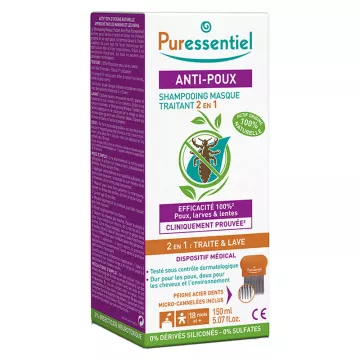

Fighting lice requires a comprehensive strategy that combines hair treatment, prevention and environmental sanitation. In 2024, thanks to advances in lice treatments and greater awareness, it's entirely possible to manage lice infestations effectively. It's essential to keep abreast of the latest methods and products to ensure fast, effective action against these pests.
What are lice and how can we get rid of them effectively?
Lice are small external parasites that feed on human blood and are mainly found in the hair. To eliminate lice effectively, it's essential to adopt a multifaceted approach that includes treating the hair, cleaning the environment and using specific anti-lice products. The use of anti-lice shampoos, lotions or sprays is recommended, following the instructions to the letter to guarantee their effectiveness.
What are the most effective anti-lice treatments in 2024?
Anti-lice treatments have evolved, offering solutions that are both effective and scalp-friendly. Among the most effective in 2024 are products based on dimethicone, a silicone that suffocates lice without using harmful chemicals. Anti-lice electric combs also represent an innovative solution, enabling lice to be detected and eliminated without the use of chemicals.
How can I prevent a lice infestation?
Prevention is key in the fight against head lice. Avoid sharing personal items such as brushes, hats and scarves. Regular use of anti-lice products as a preventive measure, especially during high-risk periods such as the start of the school year, can greatly reduce the risk of infestation. Educating children about these preventive measures is also essential.
Are natural remedies effective against lice?
Although natural remedies are often cited as alternatives to chemical treatments, their effectiveness can vary. Essential oils, such as tea tree oil or lavender oil, are renowned for their repellent action against lice. However, they must be used with care, as they can cause skin reactions. We recommend diluting them and consulting a health professional before use.
How to treat the environment in the event of lice infestation?
As well as treating the hair, it's crucial to treat the environment to prevent reinfestation. High-temperature washing (at least 60°C) of sheets, pillowcases, clothing and any fabric in contact with the hair can help eliminate lice and nits. Non-washable items can be placed in an airtight bag for two weeks to kill lice by asphyxiation.
Can anti-lice treatments be used on young children?
The use of anti-lice treatments on young children requires special care. Some products are not recommended for children under the age of two. For these young children, prefer physical methods such as careful wet combing with a fine anti-lice comb, combined with the use of natural products or gentle solutions specifically formulated for their age. It is essential to consult a health professional before applying any anti-lice treatment to a young child.
Can lice transmit disease?
Unlike some parasites, head lice are not known to transmit disease. Their main impact lies in the discomfort they cause, including intense itching and potentially scalp irritation from scratching. Although lice themselves do not transmit disease, an untreated infestation can lead to secondary infections caused by scratching.
How long does a louse live outside the head?
Head lice generally survive no more than 24 to 48 hours away from the human scalp. Their survival depends on their ability to feed on human blood; without it, they starve to death. Nits, or lice eggs, are more resilient and can remain viable on loose fabrics or hair for up to two weeks before hatching. This underlines the importance of carefully cleaning the environment during an infestation.
How to distinguish between dandruff and lice nits?
Lice nits and dandruff may seem similar at first glance, but there are some key differences. Nits are small, oval capsules that cling firmly to the hair near the scalp and cannot be easily dislodged by brushing or shaking. Dandruff, on the other hand, is a flake of dry skin that can be easily removed, and is usually located on the scalp rather than the hair. To confirm the presence of nits, use a fine lice comb to check whether the particles can be dislodged; the nits will remain firmly attached to the hair.
Can I reuse an anti-lice treatment after the first use?
Re-use of lice treatments depends on the nature of the product and the manufacturer. Some chemical treatments may lose their effectiveness once opened and exposed to the air, while others may be designed for multiple use. It's vital to read the manufacturer's instructions on storage and reuse carefully. Non-chemical methods, such as anti-lice combs, can be reused after being properly cleaned and disinfected as recommended.